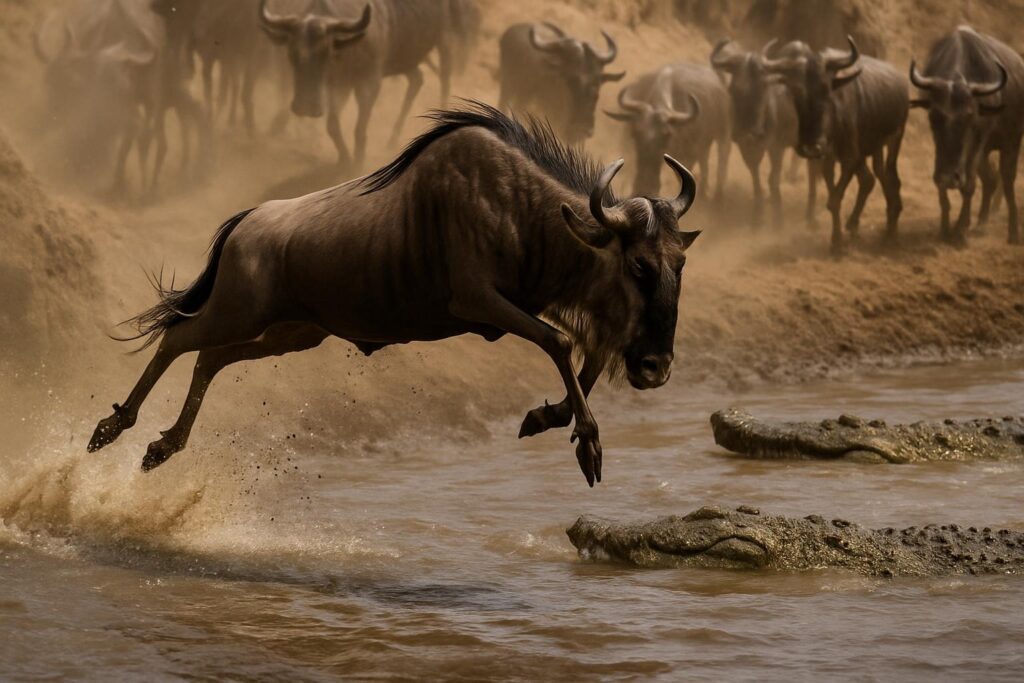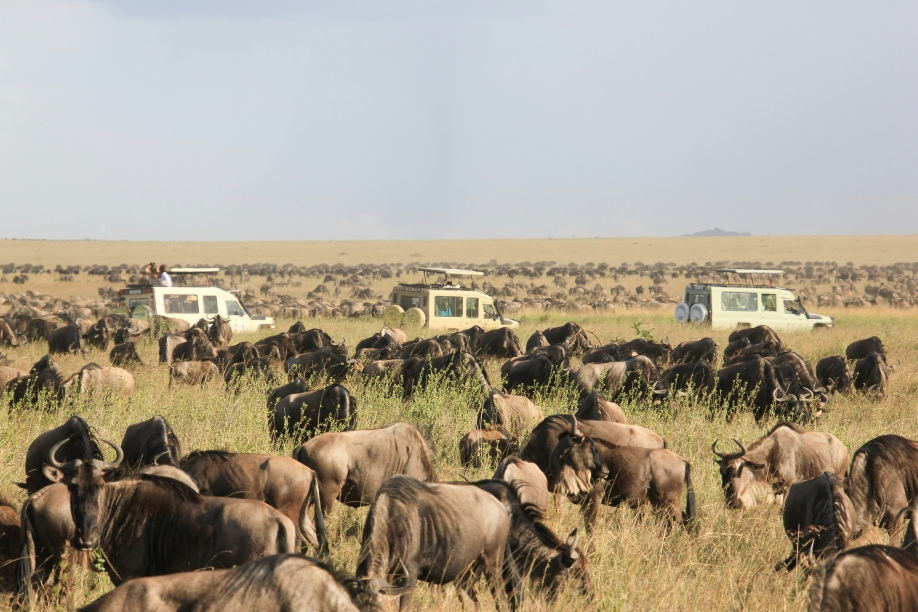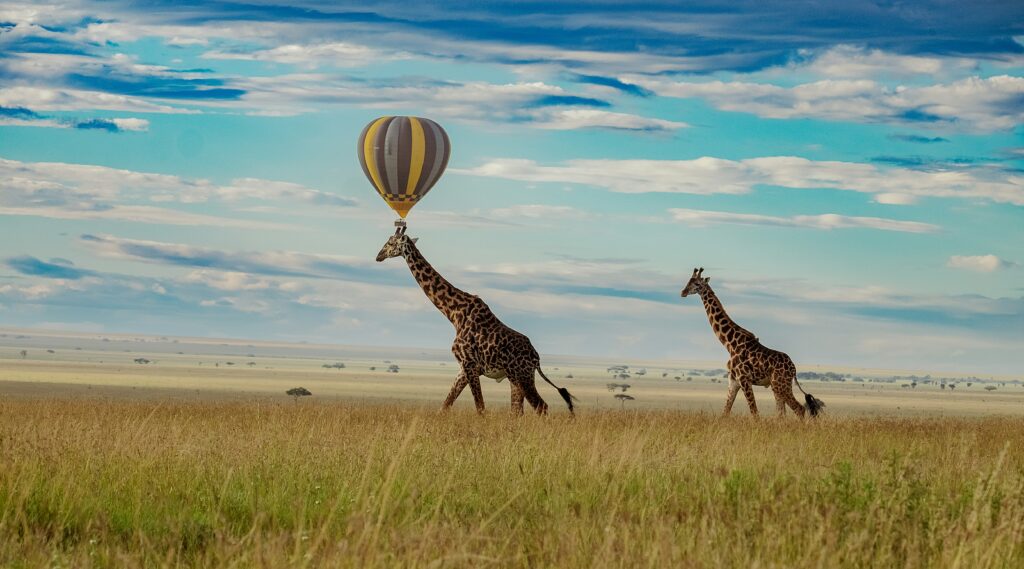Introduction to the Great Migration
What is the Great Migration?
Imagine millions of hooves pounding the earth in a continuous rhythm across the vast East African savannah. That’s the essence of the Great Migration—an annual event where over 1.5 million wildebeests, along with zebras, gazelles, and other grazers, move in search of greener pastures between Tanzania’s Serengeti and Kenya’s Maasai Mara. This isn’t just a wildlife show; it’s a dramatic, high-stakes battle for survival.
Each year, these animals undertake a cyclical journey spanning more than 1,200 miles. Following seasonal rains, the herds travel clockwise from the southern Serengeti plains to the grassy expanses of the Masai Mara, crossing perilous rivers and predator-filled landscapes. Their movement is instinctive, ancient, and deeply connected to the rhythm of the African ecosystem.
Want to understand this journey in more depth? Explore our latest feature: The Epic Journey of the Great Migration in Serengeti National Park

Why is it Considered the Greatest Wildlife Spectacle on Earth?
This isn’t your average safari—this is nature’s grandest theatre. What makes the Great Migration so extraordinary is the scale and drama involved. Picture thousands of wildebeests thundering across the savannah, crocodiles ambushing them during river crossings, and big cats waiting in ambush. It’s the circle of life playing out in raw, unscripted action.
No other event on the planet involves such a huge movement of large land animals. The unpredictability—crossings can happen in minutes or take hours—adds to the thrill. Whether you’re a first-time visitor or a seasoned traveler, witnessing the Great Migration changes your view of the natural world forever.
Curious about how to plan your own adventure? Book now with Regal Tracks Safaris and be part of this once-in-a-lifetime experience.
The Geography of the Migration
Key Locations: Serengeti and Masai Mara
The stage for this epic journey is the Serengeti-Mara ecosystem, a vast region encompassing Tanzania’s Serengeti National Park and Kenya’s Maasai Mara National Reserve. These two iconic locations form a seamless wilderness where the migration unfolds across borders, making it one of the most biodiverse areas in the world.
The Serengeti is divided into zones like the southern Ndutu plains, the central Seronera Valley, and the western corridor—all offering distinct wildlife experiences. The Masai Mara, on the other hand, is famed for its dramatic river crossings, especially across the Mara River, where crocodile ambushes are common.
Not sure which one suits your travel style better? Dive into this detailed comparison: Serengeti vs. Maasai Mara – Which Safari is Better?

Ecosystems Supporting the Migration
The migration thrives due to the interconnected ecosystems across these parks. The Serengeti’s southern plains offer fresh grass after the rains, while the western corridor and the Mara River region provide rich grazing lands and permanent water sources. These shifting conditions force the herds to move continually.
This journey isn’t only about the grazers. Lions, cheetahs, leopards, hyenas, vultures, and crocodiles depend on the migration as a critical food source. It’s a delicate ecological balance where every creature plays a role. From the thunder of hooves to the roar of predators, it’s a living, breathing ecosystem in action.
If wildlife is what excites you, check out our guide on the Top 10 African Safari Animals You’ll See on Tour
Timeline of the Great Migration
Month-by-Month Breakdown
The migration is a year-round event, and each month offers a unique spectacle:
- January to March: Calving season in the southern Serengeti. Thousands of newborns are born daily. Predators are highly active.
- April to June: The herds begin moving northwest, passing through the western corridor.
- July to September: River crossing season. Watch dramatic scenes as the herds cross the Grumeti and Mara rivers.
- October to December: The herds start moving back south as short rains begin.
Each phase offers something different, so timing your safari to match your interests is crucial. Need help choosing the best time? Check out our guide on the Best Time to Visit Serengeti National Park
Best Times to Witness Different Events
- Calving Season (Feb): Great for photographers and predator activity.
- River Crossings (July–Sept): Iconic scenes of wildebeests leaping into crocodile-infested waters.
- Return South (Oct–Nov): Less crowded, peaceful viewing with dramatic sunsets.
For a more personalized plan, explore Our Safari Packages or Contact Us directly for expert advice tailored to your travel dates.
Wildlife of the Great Migration
Main Participants: Wildebeests, Zebras, and Gazelles
At the heart of the migration are the blue wildebeests, whose numbers alone are staggering—over 1.5 million strong. But they’re not alone. Around 300,000 zebras and 400,000 gazelles tag along, creating a mega-herd that moves together, each species offering mutual protection.
Zebras, with their strong eyesight and memory, often lead the migration, while wildebeests, driven by smell and instinct, follow the rains. Gazelles are the sprinters of the group, keeping predators on their toes. This herd synergy ensures better survival rates, although danger lurks at every turn.
Their behavior, interactions, and sheer numbers create an unmatched wildlife spectacle, often described as “Africa’s Last Great Migration”.

Safari Packages and Booking Options
Custom Safari Experiences
Regal Tracks Safaris offers tailor-made journeys designed around your interests, whether that’s river crossings, calving season, photography, or luxury comfort. You can choose from:
- 3–10 day explorer packages covering Serengeti, Masai Mara, Ngorongoro Crater, and Lake Manyara
- High‑end tented camps or lodges, from intimate bush camps to luxury suites
- Private vehicles and expert guides, ensuring personalized focus and flexible itineraries
- Add‑ons: Hot-air balloon rides, walking safaris, community visits, or an extension to Zanzibar
Everything is customizable — camera gear support, dietary needs, and departure dates. Just book now or fill out our inquiry form under Our Safari Packages and our team handles the rest.
How to Book Your Great Migration Safari
- Decide on dates based on migration timing and your availability
- Choose your travel style: mobile tented camp vs. permanent lodge
- Select length & route — longer safari = more time for key wildlife events
- Contact our safari planners via Contact Us
- Customize your add-ons: balloon, walking safari, Maasai village visit
- Confirm booking with deposit, and receive pre-departure guidance
Our flexible options mean you can adjust dates close to departure to chase herds if needed, especially helpful in unpredictable seasons.
What to Expect on Your Safari
Daily Itinerary Highlights
A typical 8-day Great Migration safari may look like this:
- Day 1–2: Arrive in Arusha/Nairobi → fly to southern Serengeti/Ndutu → afternoon drive
- Day 3–4: Explore Ndutu calving sites — predator interaction & baby wildebeests
- Day 5–6: Transfer to central Serengeti for game drive or proceed to western corridor
- Day 7–8: Masai Mara for river crossings & Mara plains wildlife
Early morning and late afternoon drive times are when wildlife is most active. Midday is often spent at camp dining or relaxing before the next game drive.
Photography Tips for Capturing the Action
- Best gear: 100–400 mm lens for action; 24–70 mm for landscape
- Settings: shutter speed 1/1000+ for motion; aperture f/5.6–8 for depth
- Silhouette magic: horseback safari at sunrise offers great backlighting
- Crocodile river shots: low angle from riverbank vantage, high burst mode
Need more wildlife photography tips? Our blog covers the Top 10 African safari animals you’ll see on tour.
Expert Travel Tips
Packing Essentials
- Clothing: neutral tones, light layers, scarf, hat
- Footwear: ankle boots + camp sandals
- Accessories: polarized sunglasses, sunscreen, insect repellent, swimwear
- Tech: dual battery chargers, memory cards, power bank, UK→Kenya plug adapter
Optional but recommended: field guide, thermal thermos, compressed-air blower for camera, binoculars.
Health, Safety, and Visa Information
- Yellow Fever: certificate needed if traveling through endemic countries
- Malaria: take prophylaxis; bring anti-malarial net for bush camps
- Vaccinations: Hep A, Tetanus, Typhoid, COVID booster (if required)
- Visa: e‑visa to TAR/Kenya available online — check validity 6+ months before travel
Your safari includes guided transport, so road safety and wildlife regulations are managed by our expert staff.
Guided Safaris vs. Self-Drive
Pros and Cons of Each Option
| Option | Pros | Cons |
|---|---|---|
| Self-Drive | Budget-friendly, flexibility, privacy | Navigational challenges, rough terrain, no wildlife guidance |
| Guided Safari | Expert tracking, wildlife insight, park permits arranged, safety | Higher cost, fixed game drive schedule |
Why Guided Safaris Are Recommended
For the Great Migration, a guided safari is ideal:
- Local trackers know where the herds are & read wildlife behavior
- Government park fees and permits are handled for you
- Safety with wild animals and off-road driving in remote areas
Our guides are locals trained in wildlife biology and storytelling, maximizing your chances of witnessing migration highlights.
Best Time to Visit for Migration
High vs. Low Season
The best time to witness the Great Migration depends on what phase you want to experience. Here’s a breakdown:
- High Season (July–October): Iconic Mara River crossings in the Masai Mara. Expect larger crowds but prime wildlife action.
- Shoulder Season (January–March): Calving season in the southern Serengeti. Fewer tourists and phenomenal predator action.
- Low Season (April–May): Heavy rains make travel harder but offer lush landscapes and lower prices.
Choosing the right season is about balancing comfort, crowd level, and the events you want to witness. This detailed post breaks it down for you.
Migration Peaks and Weather Conditions
- February: Calving season in Ndutu with high predator activity.
- June–July: Grumeti River crossings in the Serengeti.
- August–October: Mara River crossings in Kenya.
- November–December: Return to southern Serengeti.
The timing of rains can slightly shift these windows. Reach out through our contact page to discuss your travel goals with a specialist.
Unique Experiences Beyond the Migration
Cultural Encounters with the Maasai People
The migration might be the star, but your trip wouldn’t be complete without a taste of East African culture. The Maasai people, known for their red shukas, tall stature, and unique jumping dance, live along the migration route. Many safaris include a visit to a Maasai boma (village), where you can:
- Participate in traditional dance and ceremonies
- Learn about Maasai customs and way of life
- Buy authentic beadwork and crafts
These cultural exchanges are authentic and respectful, curated with local community leaders.
Hot Air Balloon Safaris Over the Plains
If there’s one splurge worth every penny, it’s a hot air balloon safari at dawn over the Serengeti or Masai Mara. As the sun rises, you’ll drift silently above the plains and witness the herds from a bird’s-eye view.
Included are:
- Pre-flight breakfast with champagne
- 1-hour aerial ride
- Post-flight bush breakfast
Few experiences match the surreal beauty of watching the migration from the skies!
Conservation Efforts in the Serengeti-Mara Ecosystem
How Tourism Supports Wildlife Protection
By booking with eco-conscious operators like Regal Tracks Safaris, your safari directly supports:
- Anti-poaching units and ranger salaries
- Community conservation programs that train locals in tourism
- Wildlife corridor protection to ensure migration paths stay open
Sustainable tourism is critical in protecting this ecosystem for future generations. You’re not just a visitor—you’re a contributor to its preservation.
What You Can Do to Help
- Travel responsibly: leave no trace, follow park rules
- Choose ethical safari companies
- Support local businesses and handmade crafts
- Donate to wildlife NGOs working in the region
Your journey has the power to make a difference.
Comparing Serengeti and Maasai Mara
Which Safari Destination is Right for You?
Both parks offer unforgettable experiences—but they have unique advantages:
| Feature | Serengeti (Tanzania) | Maasai Mara (Kenya) |
|---|---|---|
| Size | Vast and expansive (larger) | Smaller but more concentrated wildlife |
| Wildlife density | Spread out—best for multi-day exploration | High density—great for shorter trips |
| Accessibility | Requires domestic flights | Easier access via Nairobi |
| Lodging | Remote luxury camps and mobile options | Wide range of lodges and tented camps |
| River Crossings | Grumeti River (June/July) | Mara River (July–October) |
Read more: Serengeti vs. Maasai Mara – Which Safari is Better?
Key Differences in Experience and Wildlife
- Serengeti offers more wilderness, perfect for longer, immersive trips.
- Masai Mara is ideal for high-impact, short safaris focused on dramatic crossings.
Want both? We offer combo safaris that cover both parks. Book now to secure your spot.
Why Choose Regal Tracks Safaris
Our Safari Philosophy
At Regal Tracks Safaris, we believe a safari should be more than a trip—it should be a transformational journey. We don’t offer one-size-fits-all packages. Instead, we focus on:
- Personalization
- Authenticity
- Community support
- Sustainable travel
Whether you’re planning a family vacation, honeymoon, or solo adventure, our team brings your vision to life.
Learn more about us.
Client Testimonials and Service Promise
Guests love us for our:
- Responsive communication
- Knowledgeable guides
- Ethical wildlife encounters
- 5-star customer support
Want to hear real safari stories? Visit our blog where past clients share their Great Migration memories.
Conclusion
The Great Migration is more than just a safari—it’s a life-changing, humbling experience that reconnects you to nature in its rawest form. Whether you’re captivated by calving season or obsessed with river crossings, this journey offers the ultimate wildlife immersion.
At Regal Tracks Safaris, we’re here to guide you every step of the way—from planning and packing to game driving and cultural encounters. With expert guides, curated routes, and ethical operations, we promise a safari that exceeds your expectations.
Ready to witness the world’s greatest wildlife show?
👉 Book Now or Contact Us to get started.
FAQs
1. How long should a Great Migration safari be?
We recommend 7–10 days to fully experience different regions and events of the migration.
2. Can I see the Great Migration in both Kenya and Tanzania in one trip?
Yes, we offer combined itineraries that let you explore both Serengeti and Maasai Mara.
3. Is the migration guaranteed at certain times?
Migration timing is driven by rainfall, so exact locations vary, but we use real-time tracking to position our guests perfectly.
4. Are children allowed on Great Migration safaris?
Absolutely! We offer family-friendly safari packages with special kid-focused guides and activities.
5. What’s included in Regal Tracks safari packages?
Most include accommodation, meals, game drives, domestic flights, park fees, and expert guides. Customization is always available.